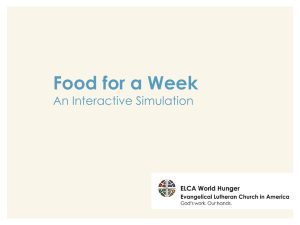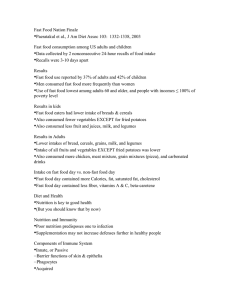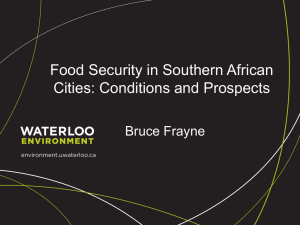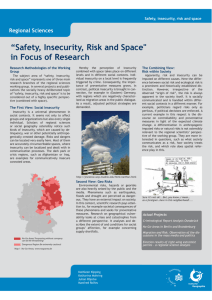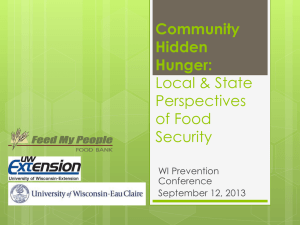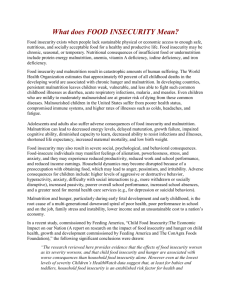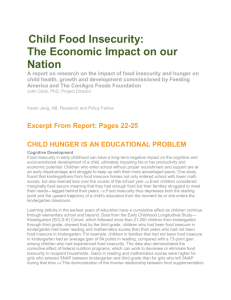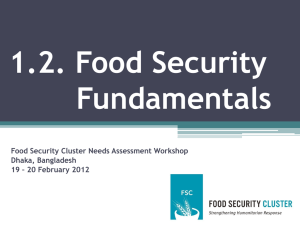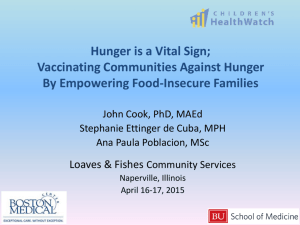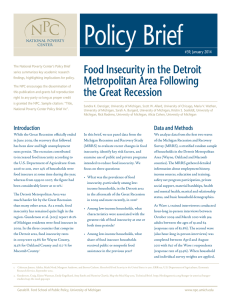Hunger - The Prevalence and Consequences
advertisement
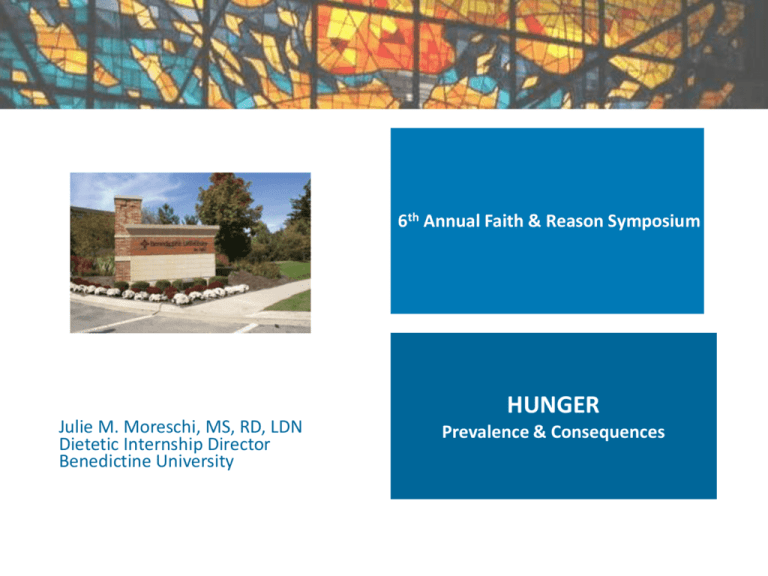
6th Annual Faith & Reason Symposium Julie M. Moreschi, MS, RD, LDN Dietetic Internship Director Benedictine University HUNGER Prevalence & Consequences Presentation is organized as follows: 1 Structure of Presentation Introduction – Definitions Factors driving the food insecurity problem Current State of food insecurity in the United States Health Consequences of Food Insecurity How Can YOU Help? Which of These Pictures Illustrates a Person Who Is Hungry? Hunger is a term which has three meanings (Oxford English Dictionary 1971) 2 What is Hunger? The uneasy or painful sensation caused by want of food; craving appetite. Also the exhausted condition caused by want of food. The want or scarcity of food in a country A strong desire or craving Source: http://www.worldhunger.org/articles/Learn/world%20hunger%20facts%202002.htm In 2011, 50.1 million Americans lived in food insecure households, 33.5 million adults and 16.7 million children. 3 What is Food Insecurity? Food insecurity is limited or uncertain availability of nutritionally adequate and safe foods or limited or uncertain ability to acquire acceptable foods in socially acceptable ways The continuum of food security is divided into four ranges, characterized as follows: High food Marginal food Low food Very low food Source: http://www.ers.usda.gov/topics/food-nutrition-assistance/food-security-in-theus/measurement.aspx Food insecurity is caused by a variety of factors: 4 What Are the Causes of Food Insecurity? Employment instability and the lack of an adequate minimum wage Uncertainties of Daily Life Problems with Access and Distribution Geography of Poverty Source: http://www.npr.org/2005/11/22/5021812/q-a-the-causes-behind-hunger-in-america 50.1 million Americans lived in food insecure households, 33.5 million adults and 16.7 million children. 5 Prevalence of Food Insecurity in the United States 14.9 percent of households (17.9 million households) were food insecure. 5.7 percent of households (6.8 million households) experienced very low food security. Food insecurity exists in every county in America, ranging from a low of 5 percent in Steele County, ND to a high of 37 percent in Holmes County, MS Source: http://feedingamerica.org/hunger-in-america/hunger-facts/hunger-and-povertystatistics.aspx Households with children reported food insecurity at a significantly higher rate than those without children, 20.6 percent compared to 12.2percent. 6 Prevalence of Food Insecurity in the United States Households that had higher rates of food insecurity than the national average included Households with children headed by single women (36.8 percent) Single men (24.9 percent), Black non-Hispanic households (25.1 percent) Hispanic households (26.2 percent). Source: http://feedingamerica.org/hunger-in-america/hunger-facts/hunger-and-povertystatistics.aspx Map The Meal Gap 7 Prevalence of Food Insecurity in the United States http://feedingamerica.org/hunger-inamerica/hunger-studies/map-the-mealgap.aspx An adult that is food insecure can suffer from several health consequences including: Inability to have a fully active life 8 Health Consequences of Food Insecurity Lower scores on physical and mental health exams Increased risk of developing Diabetes Increased risk of some cardiovascular diseases Higher levels of aggression and anxiety Slower developing social skills Source: http://feedingamerica.org/hunger-in-america/impact-ofhunger/physical-and-mental-health.aspx An child that is food insecure can suffer from several health consequences including: 9 Health Consequences of Food Insecurity Low Birth Weight delayed development, poorer attachment, and learning difficulties in the first two years of life More frequent hospital visits Higher rates of asthma and anemia Dental problems Poorer physical quality of life which may reduce participation in social and athletic activities Increased behavior problems such as bullying, fighting, hyperactivity, aggression, anxiety, and moodiness Source: http://feedingamerica.org/hunger-in-america/impact-of-hunger/childdevelopment.aspx Donate Volunteer 10 What Can You Do? Support Retention of Food Program Funding Organize a Food Drive For More Information… Action Against Hunger http://www.actionagainsthunger.org/ Bread for the World Institute http://www.bread.org/ Feeding America http://feedingamerica.org/ Feed the Future http://feedthefuture.gov/ Initiative Save Food http://www.save-food.org/ Loaves and Fishes Community Pantry http://www.loaves-fishes.org/ No Kid Hungry http://www.nokidhungry.org/?gclid=CM6M38fFvbYCFZE-Mgod8zMAWA Northern Illinois Food Bank http://solvehungertoday.org/ Nutrition.gov (Links to a variety of food insecurity resources) http://www.nutrition.gov/food-assistanceprograms/hunger-and-food-insecurity The Role of the Supplemental Nutrition Assistance Program in Improving the Health and Well-Being of Americans by the Food Research and Action Center (FRAC) http://frac.org/pdf/snap_and_public_health_2013.pdf United States Department of Agriculture (USDA) Economic Research Service http://www.ers.usda.gov/topics/food-nutrition-assistance/food-security-in-the-us.aspx USDA Food Access Research Atlas http://www.ers.usda.gov/data-products/food-access-research-atlas.aspx World Hunger Notes http://www.worldhunger.org/ Why Hunger Blog http://blog.whyhunger.org/
